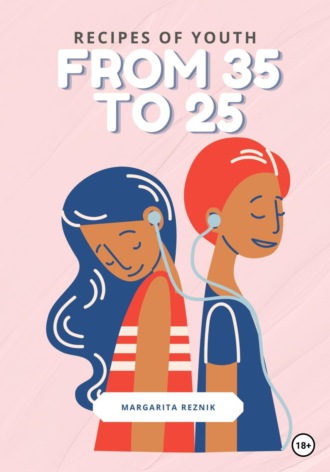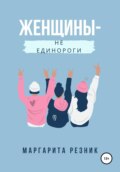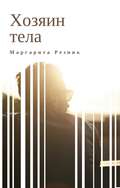
Маргарита Резник
Recipes of youth: from 35 to 25
Introduction
Let's start with the fact that I wouldn't want to be in my twenty-five years. In fact, I wouldn't even want to be in my twelve years. And frankly, neither would anyone else's. Are you kidding? Good. Let this book be a light and helpful read for you.
Instead of returning to a time of youthful acne and unrequited love, I would like to share with you a story about becoming healthier than we ever were before. And yes, this book will be useful not only for women, but also for men.
Human beings are amazing creatures. So often we pretend and pretend that everything is fine, even when in fact it is not. At the age of twenty-three, I convinced myself that I was full of strength and health. I relayed this to friends and family, but every year I was taken to the hospital in an ambulance with a transient ischemic attack. I wanted to hide from everyone at the time, and only my ex-husband knew of my suffering.
So, why did I decide to write this book? Because in the last year I've seen an incredible number of young women and men who, just like me once did (back in my early twenties), deceive themselves and their audiences on Instagram by claiming to be healthy.
Guys writing about fitness, yoga, nutrition, spiritual enlightenment, finance and psychology have come to me with the same problems: terrible migraines, neck, back and shoulder pain, muscle stiffness, hernias, scoliosis and panic attacks.
When I helped them, they sincerely thanked me, but they never told anyone about my center, for fear that someone would find out about their problems, which were already behind them.
I won't name their names in the book. But I do want to tell you how to begin to trust yourself, not your teachers. I want to share with you ways that you can begin to listen to your body and accept only what it needs, not what advertising campaigns and fashion trends impose.
So let's get started.
In a world where information about healthy living and wellness is readily available, we often forget one important thing: Every body is unique. What works for one person may not work for another. Instead of blindly following fashion trends and society's dictates, let's learn to listen to our bodies and trust them.
The road to health begins with awareness. Awareness of our needs, of the signals our body sends us. Often we ignore these signals, overloading ourselves with food, alcohol, and the wrong lifestyle in general. But our body is not silent-it lets us know about problems through pain, fatigue, and malaise.
The next step is mindfulness. Be attentive to what you eat, what physical activity you devote time to, how you rest. Notice how your body responds to different foods, exercises, and routines. Notice the changes in your well-being and energy. This will help you understand exactly what works for you and your body.
However, awareness and mindfulness are only half the battle. It is important to take responsibility for your health and take steps to improve it. This may include changing your diet, adding exercise, managing stress and seeking help from a neck vascular specialist (more on that later).
Of course, it's not always easy. We all face temptations and challenges on the road to health. But I'm sure every step in that direction is worth the effort. After all, it's so important for us to be our best selves-physically, emotionally, and spiritually.
So what do you do to start trusting yourself and your body?
First, start by understanding your health goals and priorities. Ask yourself the question: What exactly do I want to achieve? It could be improved physical fitness, reduced stress, increased energy, or just a general sense of well-being. When you are clear about your goals, it becomes easier to make decisions that support your health.
Second, pay attention to your lifestyle. Regular exercise, a healthy diet, adequate rest and sleep are all important parts of a healthy lifestyle. Find activities that make you feel good and are right for you. This can be gymnastics, running, dancing, or any other type of physical activity. Also pay attention to your diet – choose fresh and natural foods that will provide your body with the necessary nutrients.
Third, take time for introspection and self-observation. Notice what factors are affecting your well-being. Maybe certain foods are causing you unpleasant symptoms or making your health worse. Or you notice that certain exercises are giving you more benefits and energy. Write down your observations and use them to make decisions for your health.
Finally, be patient and compassionate with yourself. The process of making lifestyle changes and achieving health takes time and persistence. Don't expect instant results, because health is a long-term investment in yourself. Be prepared for challenges and setbacks along the way. But remember that every step, even the smallest one, brings you closer to your goal.
Don't forget the emotional aspect of health. Your mental state also affects your overall well-being. Pay attention to your emotions, stress, and how you manage them. Sometimes taking care of your emotional health can be just as important as taking care of your physical health.
Finally, remember that you are a unique and beautiful person. Don't compare yourself to others or try to conform to the ideals and standards set by society. You deserve a healthy and happy life, and only you know what works best for you.
So trust your body, listen to its needs and make decisions based on your intuition and knowledge. You know yourself best. And remember that being healthy is not only a state of being, but also a journey we take every day.
So let's begin this journey to health and well-being today. Show love and care for yourself, and you will see your life change for the better. You deserve to be a healthy, happy and confident woman (or man) at any age.
Let's embark on this exciting and important journey together!
My Story
My story began when I was two years old. As far back as I can remember and realize, I was faced with health problems at a very early age. It was almost infancy, and one of my most vivid memories was my attempts to cope with a headache. It wasn't easy as a little girl-sometimes in the middle of the night I would stand on my head in a rhombic pose, trying to cope with the incredible pressure felt inside my head.
My parents had to face a challenge, and I was diagnosed with high intracranial pressure. The doctors prescribed heavy pills for me, but my mother noticed that a certain posture, with my forehead in the pillow-pelvis up, which I was taking, helped me get some relief. After standing for a while, the headache would begin to subside, and I could fall asleep peacefully, go to daycare, and go on with my daily life.
Over time, headache medications appeared, and I started taking them. However, with the emergence of school worries, the headache attacks began to become more frequent. I was seen by a child neurologist in the small town of Olonets, in Karelia, where I spent my childhood. Though the quality of medical care in that city left much to be desired, there was one competent physician who helped me. She diagnosed me with a birth injury involving a subluxation of the third cervical vertebra.
However, with my condition, they did not know what to do or how to correct the situation with subluxation of the second and third cervical vertebrae. The doctors only diagnosed me and prescribed pills for the rest of my life. I continued to go to school and suffer from occasional headaches like so many others. I was also told that I had scoliosis, but nothing needed to be done about it because it was supposedly normal and every first person has scoliosis. This approach was based on statistics, but the conclusion was clearly wrong. Instead of looking for ways to combat the problem, it was assumed that it was just the norm.
The neurologist suggested that I do physical therapy (therapeutic exercise) and massages, and she also advised me to use physical therapy procedures, such as Darsenwal, which helped to strengthen the capillary network of the scalp. I tried these methods, but did not notice any significant changes, perhaps only a slight improvement in my general condition. I did not like exercising because it increased my headaches, fatigue and tachycardia (palpitations), which put me in a bad condition.
One day, when my mother wasn't home and a severe pain in my heart came over me, I experienced a terror. My heart was pounding so hard, and then it suddenly stopped, as if it froze before it started beating again. I was frightened and immediately called my older sister for help. Before my mom got home, we called the doctor. I was diagnosed with vegetovascular dystonia, which meant autonomic nervous system disorder and vascular dysregulation. It was like something out of a medical textbook.
As time passed, I started medical school and realized that my previous diagnoses were simply superficial and did not address the underlying problem. They were a kind of reprimand, describing my symptoms, but offering no long-term perspective.
When I saw my older sister receiving chiropractic care, I knew something was wrong. Her back pain, caused by scoliosis, only got worse after this intervention. Her arms and legs began to go numb. This was due to the fact that chiropractic treatment not only shifts the vertebrae, but also traumatizes the surrounding structures: spinal cord sheaths, nerves, vessels, and intervertebral discs. As a result, people often have problems such as pinched nerves and limb numbness. This is very dangerous, and those who have managed to avoid such complications should be congratulated.
The next important episode happened when I was in eighth grade. For two weeks I suffered from terrible headaches and dizziness. One day I woke up and realized that I could not get out of bed. With each movement the dizziness got worse, my heart was pounding, and I couldn't do anything. Although there was no panic, I felt I could have died. This condition lasted for two weeks. I was fed while lying on my side, and I could barely get up to go to the bathroom. It was terrible.
After that my mother took me to a medical commission, and I was placed on disability for a year. Teachers came to my house, and I went back to school. The headaches went back to their previous rhythm. Although it did not happen again, I still had a fear that it could happen again.
By the time I was twenty-three, I had already been admitted to the hospital several times by ambulance with a diagnosis of transient ischemic attack, a transient cerebral circulation disorder. It is accompanied by severe headaches, nausea, palpitations and panic. These conditions are caused by birth trauma and vasoconstriction, which leads to a lack of oxygen and insufficient blood flow to the brain.







